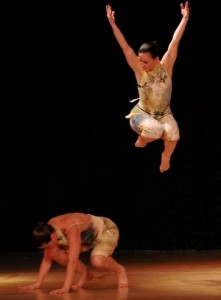
Lineage Dance / photo by Dean Zatkowsky
Even when Hilary Thomas is teaching biology to students at Flintridge Prep, she is dancing. With degrees in psychology and dance from Santa Clara University, perhaps it’s no wonder. She studies the human body with the self-knowledge of a dancer, often teaching it with movement association, and acts as artistic director and principal choreographer for Lineage Dance, the troupe she helped found in Pasadena. Now with the premiere of her newest work for Lineage, called “The Brain in Motion,” Thomas’ dual passions for science and dance are coming together more than ever before.
The evening-length work was inspired by the Pasadena Art & Ideas Festival theme: origins. “I immediately thought of the brain,” Thomas declares, “the ultimate ‘origin’ of our existence as human beings.” The ideas Thomas had toyed with for years finally found their venue.
After a preview performance in May, “The Brain in Motion” also found its charitable cause. Sarah DeBoard Marion, who knew about Lineage’s mission to pair dances with worthy causes of common theme, approached Thomas about the Travis Research Institute. Thomas thought it was “a perfect fit,” so all of the proceeds from “The Brain in Motion” will go toward Alzheimer’s research there.
Much of the choreography comes from Thomas’ knowledge in the sciences. But like most work in the Lineage repertoire, it is equal parts didactic and abstract. In previews, this balance of instruction and abstraction has been apparent. Dancers bound across the stage as firing synapses, but the overlaying details are distinctly Thomas’, expressing a more visceral understanding of the mind and of science.
Considering the ballet background common to all of the Lineage dancers, there will be an impressive degree of athleticism on display at the Art & Ideas performance on Oct. 30, and again on Nov. 5 and 8, at the Pacific Asia Museum. That perhaps creates the most compelling aspect of “The Brain in Motion.” After months of any rehearsal, steps and places are a part of “muscle memory.” It’s a trick, or simply a fact, of the trade: choreography wires itself, so to speak, into muscle-use patterns, freeing up the mental presence necessary for stage performance. “Without that muscle memory,” Thomas points out, “I don’t think we’d be as free to perform and project emotions.” (And with aspects of Alzheimer’s and Parkinson’s Disease playing into “The Brain in Motion,” the preciousness of thought itself does not go without attention.) Furthermore, many of the dancers in Lineage have been working together for so long, Thomas points out, that even their unspoken communication recalls the cooperative parts of the brain.
The premiere is part of Lineage’s 10th season, and “The Brain in Motion” may be the perfect anniversary gift from Thomas to herself. “I am able to bring to life,” she says, “all of the dancing that goes on in my head while I’m reading, talking, and teaching about the brain.”
“The Brain in Motion” will premiere at the Pasadena Art & Ideas Festival: Origins on Friday, Oct. 30, at 8 p.m. at the Pacific Asia Museum, 46 N. Los Robles Ave., Pasadena. It will be performed again on Thursday, Nov. 5, at 7:30 p.m. and Sunday, Nov. 8, at 3 p.m. For more information, or to order tickets, visit www.lineagedance.org or www.artideasfestival.org, or call the Pacific Asia Museum at (626) 449-2742, ext. 31.





